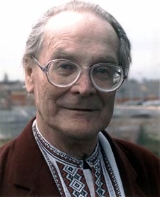
Konstantin Buteyko
Encyclopedia

Buteyko method
The Buteyko method or Buteyko Breathing Technique is a form of complementary or alternative physical therapy that proposes chronic "breathing retraining" as a treatment for asthma as well as other conditions. The method takes its name from the late Ukrainian doctor Konstantin Pavlovich Buteyko ,...
for the treatment of asthma and other breathing disorders.
Early life
Konstantin Pavlovich Buteyko was born on 27 January 1923 into a farming family in Ivanitsa, near KievKiev
Kiev or Kyiv is the capital and the largest city of Ukraine, located in the north central part of the country on the Dnieper River. The population as of the 2001 census was 2,611,300. However, higher numbers have been cited in the press....
, Ukraine
Ukrainian SSR
The Ukrainian Soviet Socialist Republic or in short, the Ukrainian SSR was a sovereign Soviet Socialist state and one of the fifteen constituent republics of the Soviet Union lasting from its inception in 1922 to the breakup in 1991...
. His father was a keen mechanic and he followed this passion, studying mechanical engineering at Kiev Polytechnic. World War II
World War II
World War II, or the Second World War , was a global conflict lasting from 1939 to 1945, involving most of the world's nations—including all of the great powers—eventually forming two opposing military alliances: the Allies and the Axis...
interrupted this study however and he was sent to join a motorcade
Motorcade
A motorcade is a procession of vehicles. The term motorcade was coined by Lyle Abbot , and is formed after cavalcade on the false notion that "-cade" was a suffix meaning "procession"...
supplying the front lines. During the war, Buteyko had become tired of mechanics and made the decision to go into medicine.
Medical training
In 1946 Buteyko enrolled at the First Moscow Institute of MedicineMoscow Medical Academy
I.M. Sechenov First Moscow State Medical University is the oldest and the largest national medical higher educational institution in the Russian Federation. For more than 250 years I.M. Sechenov First Moscow State Medical University, previous name - I.M. Sechenov First Moscow Institute of...
. He gained his degree with Honors in 1952 and became a resident. During his medical studies he was given a project of making observations on patients’ breathing rates in relation to the severity and prognosis of their illness. He soon came to the conclusion that there was an association between these two factors, such that as a patient’s condition became more severe so their breathing rate increased.
Buteyko reasoned that if there really was a connection between hyperventilation and illness it should be possible to reverse this by deliberate breath control. Having already made a study of several texts on yoga he was aware of exercises in breath restriction and so began to experiment both on himself and with his patients. These early trials became known as the Buteyko method.

